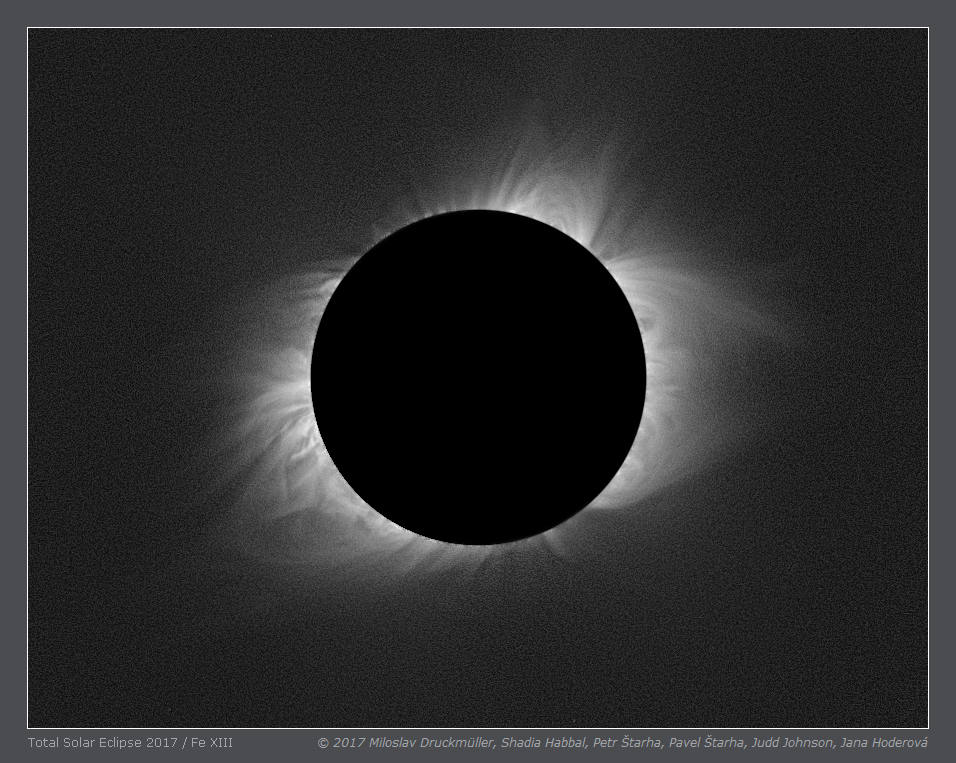
Fe XIII, 1074.7 nm
Our expedition observed emission of following ions in the visible
and near IR wavelength range: Fe IX (435.9 nm), Fe X (637.4 nm),
Fe XI (789.2 nm), Fe XIII (1074.7 nm), Fe XIV (530.3 nm) and
Ni XV (670.2 nm). These emission lines provide an excellent
diagnostic tool
for probing the physics of the solar corona. This is clear from the following graph.
The Fe XIII line at 1074.7 nm is very interesting especially in comparison with
Fe XIV line at 530.3 nm.
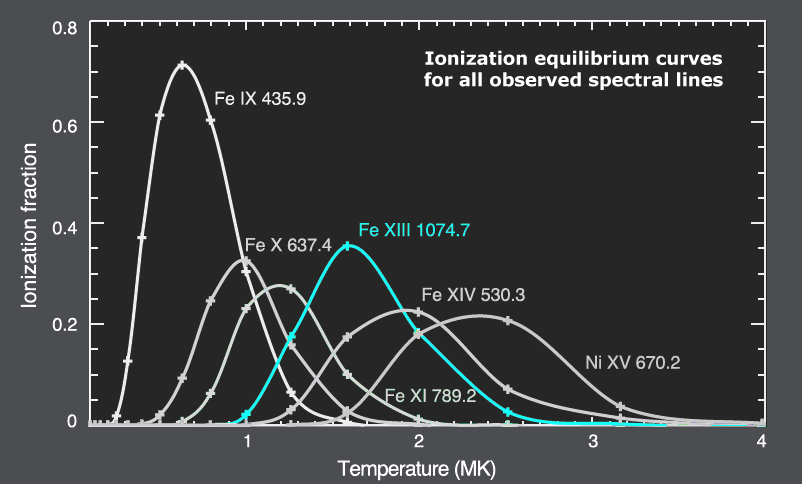 Even though Fe XIII at 1074.7 nm is a strong near IR emission line it is a problem to find a
suitable
camera for that wavelength. Ordinary CCD cameras have a quantum efficiency of a few percent at that
wavelength. There exist special IR cameras but they have very low resolution and they are expensive. We
used Atik 414EX camera with Sony ICX825 chip which is a good compromise between resolution and sensitivity.
The
Fe XIII 1074.7 nm line is contaminated by continuum like the other observed lines as you may see
in the following pair of images. The left one was taken through a narrow band filter (bandwidth 0.5 nm)
with a transmission band centered on Fe XIII 1074.7 nm emission line. The right image was
taken through a filter with a transmission band outside the Fe XIII line in the continuum. It is clearly
visible that the left image is contaminated by continuum. It is not advisable to use a filter with a narrower
band of transmission because the emission line is thermally broadened; hence, a too narrow band filter would
make the situation even worse. Therefore it is necessary to make a precise photometric calibration of
all images and then subtract the continuum - the right image from the left one. You may see these two images
as an animation as well.
Even though Fe XIII at 1074.7 nm is a strong near IR emission line it is a problem to find a
suitable
camera for that wavelength. Ordinary CCD cameras have a quantum efficiency of a few percent at that
wavelength. There exist special IR cameras but they have very low resolution and they are expensive. We
used Atik 414EX camera with Sony ICX825 chip which is a good compromise between resolution and sensitivity.
The
Fe XIII 1074.7 nm line is contaminated by continuum like the other observed lines as you may see
in the following pair of images. The left one was taken through a narrow band filter (bandwidth 0.5 nm)
with a transmission band centered on Fe XIII 1074.7 nm emission line. The right image was
taken through a filter with a transmission band outside the Fe XIII line in the continuum. It is clearly
visible that the left image is contaminated by continuum. It is not advisable to use a filter with a narrower
band of transmission because the emission line is thermally broadened; hence, a too narrow band filter would
make the situation even worse. Therefore it is necessary to make a precise photometric calibration of
all images and then subtract the continuum - the right image from the left one. You may see these two images
as an animation as well.
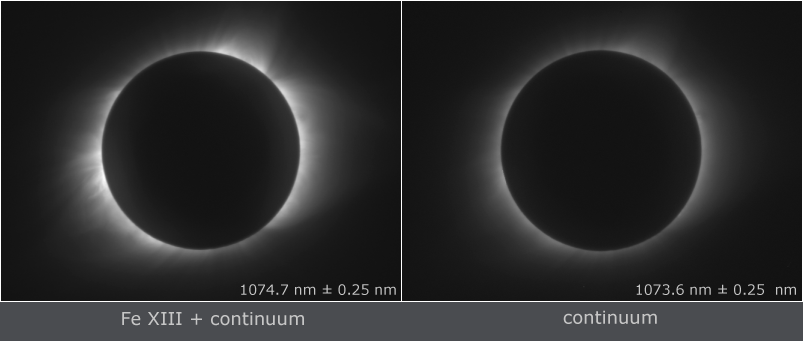 It is very interesting to compare this pair of images with the analogous pair for Fe XIV 530.3 nm.
It is very interesting to compare this pair of images with the analogous pair for Fe XIV 530.3 nm.
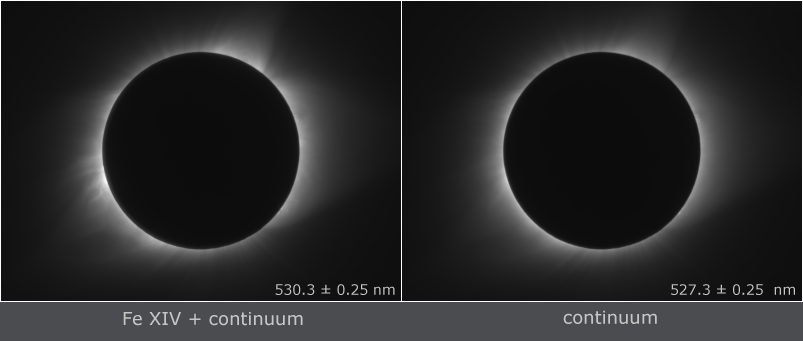 It is clearly visible that Fe XIII is significantly stronger relative to the continuum than Fe XIV.
That is why the intensity of continuum at 1074.7 nm is approximately 3× weaker relative to
530.3 nm wavelength. It means that resonance excitation of Fe XIII ion by photospheric light
is 3× weaker as well. The consequence is that the drop of emission intensity with distance
from the Sun is much steeper in Fe XIII in comparison with Fe XIV image as you may see in the
following pair of final processed images.
It is clearly visible that Fe XIII is significantly stronger relative to the continuum than Fe XIV.
That is why the intensity of continuum at 1074.7 nm is approximately 3× weaker relative to
530.3 nm wavelength. It means that resonance excitation of Fe XIII ion by photospheric light
is 3× weaker as well. The consequence is that the drop of emission intensity with distance
from the Sun is much steeper in Fe XIII in comparison with Fe XIV image as you may see in the
following pair of final processed images.
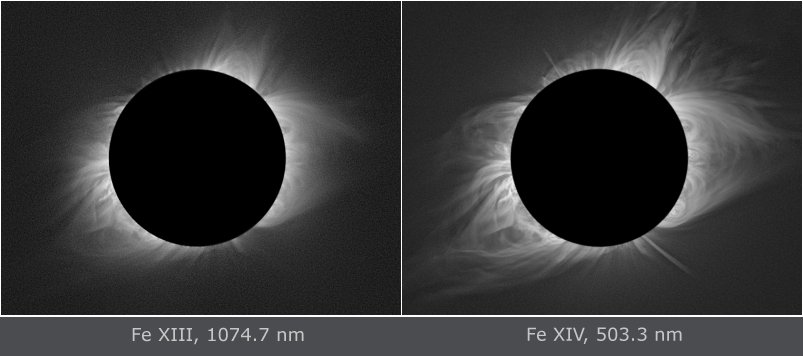 The transition between the dense coronal plasma, where recombination of ions and
collision excitation takes place, and where only resonance excitation by photospheric
light is possible, is evident by comparing these images. The area with collisionless plasma is significantly
weaker in Fe_XIII image.
More images of Fe ion emission obtained during 2017 eclipse you may find of following pages:
The transition between the dense coronal plasma, where recombination of ions and
collision excitation takes place, and where only resonance excitation by photospheric
light is possible, is evident by comparing these images. The area with collisionless plasma is significantly
weaker in Fe_XIII image.
More images of Fe ion emission obtained during 2017 eclipse you may find of following pages:
|
| Image | Fe_XIII_WhiskeyMountain_ACHF.png |
| Date | 21. 08. 2017 |
| Time | 2nd contact 17:36:46 UT, 3rd contact 17:39:08 UT |
| Place | Whiskey mountain, Wyoming, USA |
| Coordinate | N 43° 25.234', W 109° 37.883', Alt. 3165 m |
| Conditions | Clear sky, solar altitude 51° above horizon |
| Optics | 2× Achromat 4/200 mm equipped with following narrow band filters:
On-band filter: Andover, center wavelength: 1074.7 nm, bandwidth 0.5 nm
Off-band filter: Andover, center wavelength: 1073.6 nm, bandwidth 0.5 nm |
| Camera | 2×Atik 414EX |
| Exposure | 1 s - 32 s |
| Processing | Composition of 24 eclipse images (12 On-band and 12 Off-band) taken with two cameras. Images were calibrated by means of dark frames and flat-fields, aligned by means of phase correlation, composed by means of LDIC 6.0 software, continuum was removed from Fe XIV emission by subtracting the Off-band images, than resulting image was processed using Corona 5.0 software in order to visualize coronal structures. Final processing was done using ACC 6.1 software.
Image processing by Miloslav Druckmüller |
| Software | Astro D3F 2.0, PhaseCorr 7.0, LDIC 6.0, Corona 5.0, Sofo ACC 6.1 |
| Copyright | © 2017 Miloslav Druckmüller, Peter Štarha, Shadia Habbal, Pavel Štarha,
Judd Johnson, Jana Hoderová |

|
Miloslav Druckmüller
Institute of Mathematics, Faculty of Mechanical Engineering
Brno University of Technology, Czech Republic
druckmuller@fme.vutbr.cz
|
Page last update: 26.11.2019
|
|

